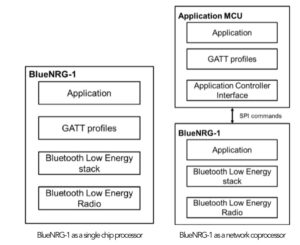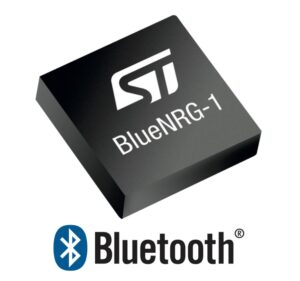Bluetooth® Low Energy (Bluetooth LE) brings a well-known, trusted, and reliable wireless network to small battery powered devices. It has strongly contributed to the increased popularity of smart home appliances, wearables and the Internet of Things (IoT) in general. However, great products need to be more than simply compatible with that standard. That’s why ST offers solutions that facilitate the adoption of this new protocol. The latest example is the BlueNRG–1, a Bluetooth LE System-on-Chip (SoC). It features an ARM® Cortex-M0® 32-bit architecture, 160 KB of programmable Flash memory, and 24 KB of RAM. The chip has two major advantages : it provides reliable features that greatly enhance a device’s functionality, and brings great power consumption with its low-power modes.
The Meaning of Great Bluetooth LE Devices

The network processor comes with a battery voltage and temperature monitor. It ensures, for instance, that devices do not overheat. Users are also notified when it is time to charge or replace the battery.
This is especially important in Bluetooth LE devices that are installed then left on their own. Users won’t constantly check the power level of a smart lock, nor the temperature of a device left in the sun in a living room. However, because these features are included in the BlueNRG–1 SoC, engineers can quickly offer features that will greatly enhance the user experience.
The presence of an ARM® Cortex-M0® core also means that application code can run on the SoC. ST provides a library with C code that allows engineers to offer master and slave support, setup clients and a server, or provide AES–128 encryption and decryption. This allows the BlueNRG–1 SoC to run powerful single chip applications, simplifying designs and reducing the device’s dimensions.
Finally, the flexibility of the architecture employed by ST means the chip can also be a network coprocessor. A library offers tools to quickly support and use the SPI interface to communicate with the application processor. In this setup, the BlueNRG–1 chip simply handles the Bluetooth LE Stack and radio as well as any applications the system wants it to run.

Bluetooth LE? Low Energy in Every Situation
The other significant advantage offered by BlueNRG–1 stems from its low consumption and exceptional power management. Because the SoC uses an efficient DC-DC converter, the operating supply voltage has been reduced from 2 V on the BlueNRG chip to 1.7 V on the BlueNRG–1. Furthermore, current consumption can drop as low as 1 µA when in sleep mode, which still keeps the Bluetooth LE Stack active to make the sure the SoC is quickly functional when it wakes up.
BlueNRG–1 actually offers three different low-power modes. Products that will use this SoC often rely on small batteries, which means that saving energy can have a big impact on the autonomy and therefore usability of the device.
The first low-power setting is a CPU-Halt mode. It turns only the CPU off, meaning that the peripheral devices can still operate and send messages to wake it up. This is useful if the system is idle and would rather save energy than waste resources. This mode saves the least amount of power, but allows the system to very quickly wake up.
The second profile is a typical sleep mode that stops the CPU and the peripherals. The low-speed oscillator block and the external wake-up source block remain operational. Thus, the BlueNRG–1 can be awakened by a timer, an external source, or commands to some of its IOs. This mode offers greater energy savings, but it takes longer to wake up because the high-speed oscillator must be stable again before the chip can execute applications.
Finally, the third setting is a standby mode in which both the low and high-speed oscillators are off, and external sources or timers cannot wake the SoC up. The BlueNRG–1 can only leave this mode when it receives a command from one of its IOs. Since almost the entire chip is shut down, standby offers the greatest amount of energy saving. However, it takes the longest amount of time to recover from it.
These features allow the BlueNRG–1 a degree of flexibility that greatly increases its efficiency. The different low power modes allow developers to adapt to different situations. This means they can find the best balance between performance and power consumption and their products become reliable, efficient and powerful. For more information on BlueNRG–1, please visit ST’s website. For more information on the different Bluetooth standards please refer to the Bluetooth SIG’s website.
